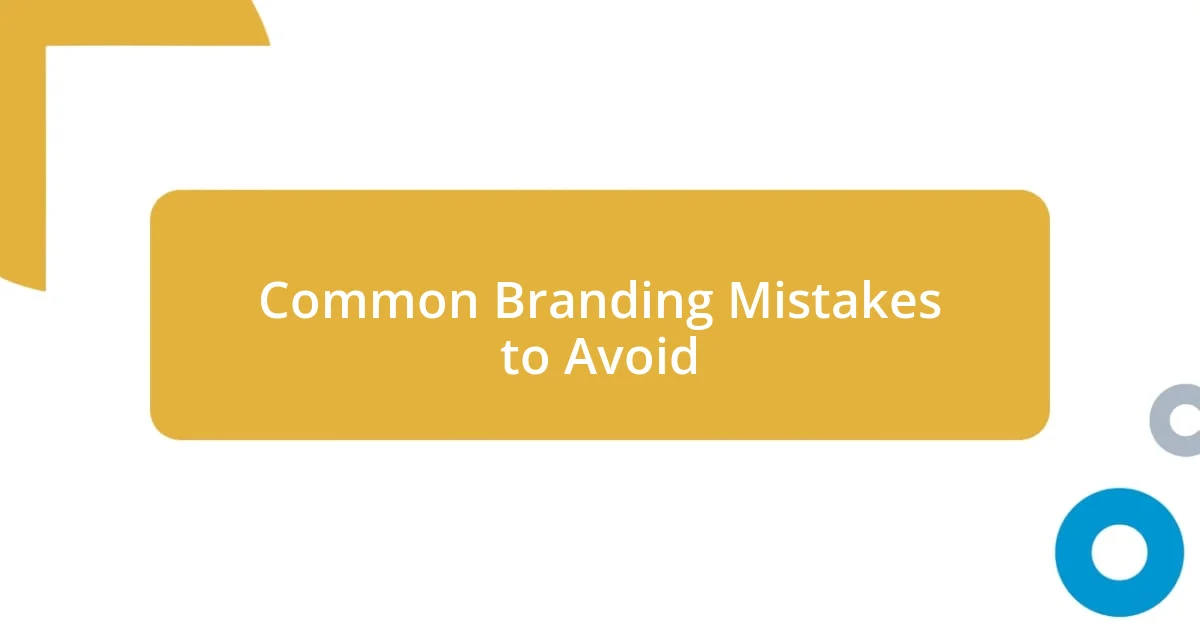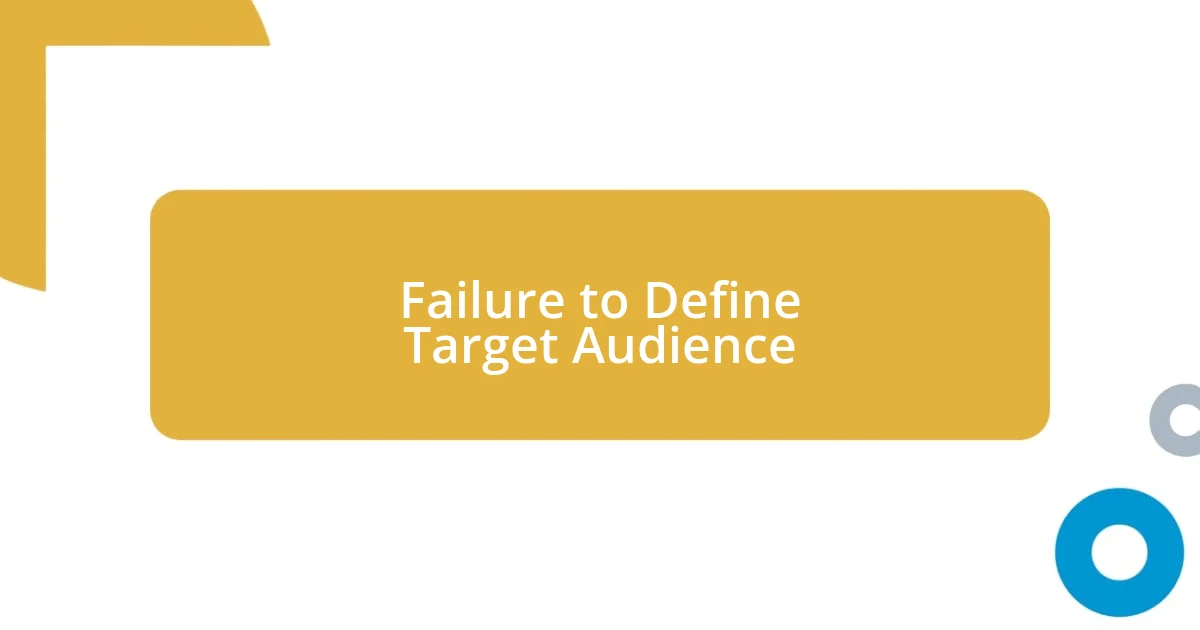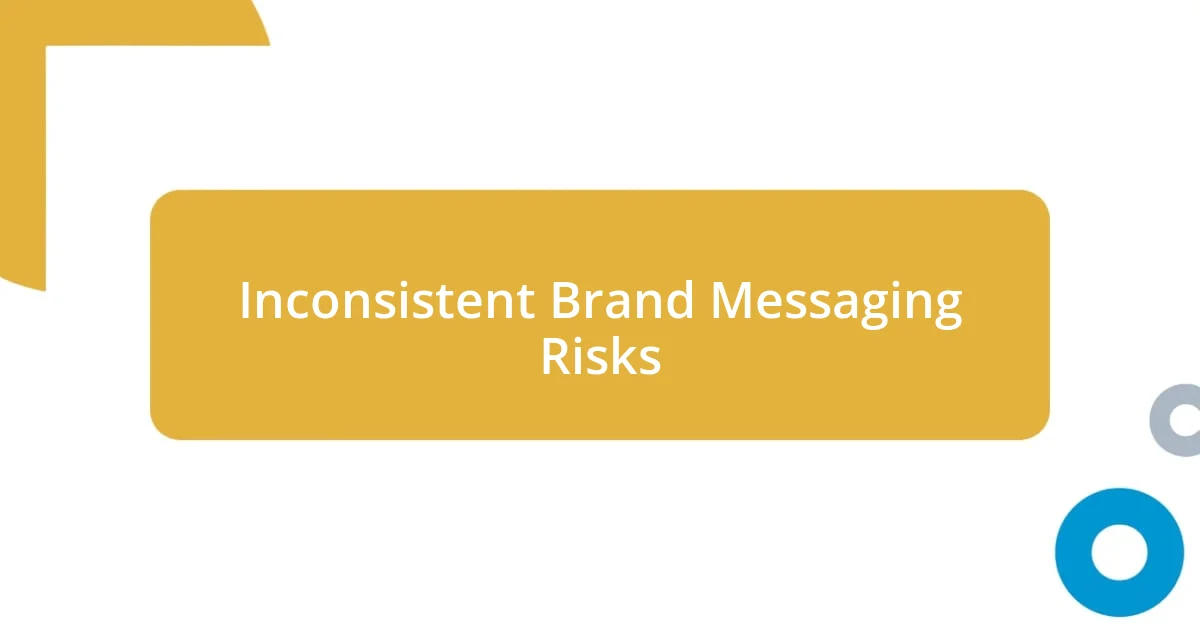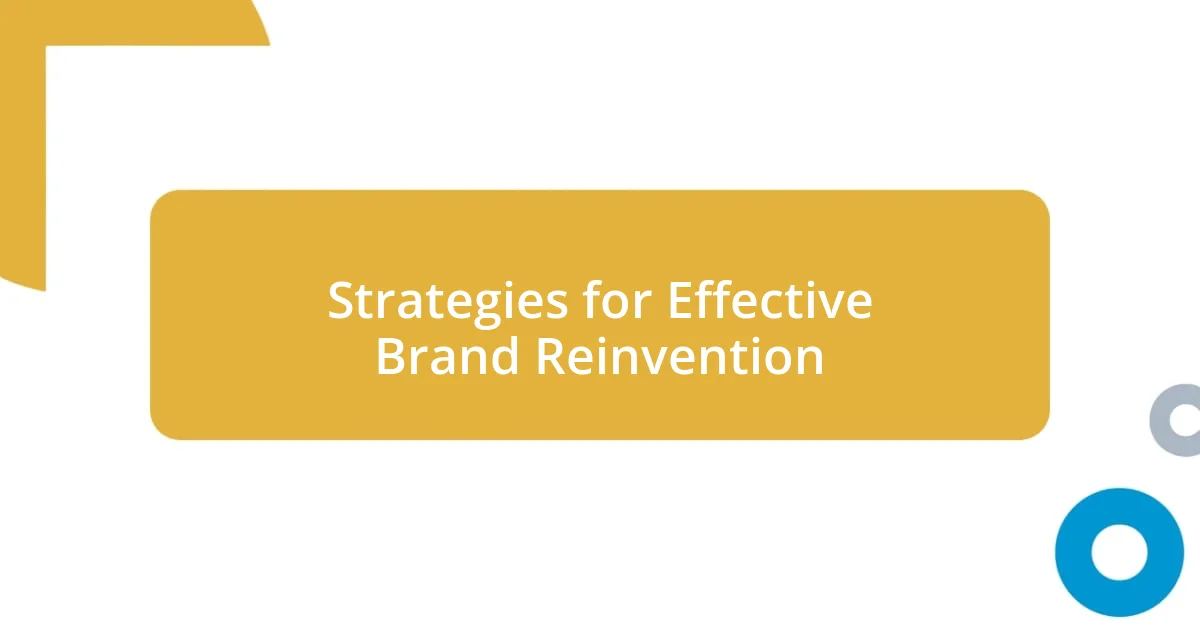Key takeaways:
- Effective branding transcends logos and slogans, focusing on emotional connections and aligning with consumer values for differentiation and loyalty.
- Common branding mistakes include inconsistency, neglecting the target audience, and ignoring customer feedback, which can lead to a disconnected brand identity and disengaged consumers.
- Reinventing a brand involves understanding customer values, maintaining authenticity, and using innovative strategies like limited campaigns to engage audiences and ensure relevance.

Understanding Branding Importance
Branding is not just about a logo or a catchy slogan; it encapsulates the essence of a business. I remember the first time I came across a brand that resonated deeply with me – it was their story, their values, and the emotional connection they fostered. Isn’t it fascinating how a strong brand can evoke feelings of trust and loyalty in consumers?
When I think about my own experiences as a consumer, I realize that a brand’s identity shapes my purchasing decisions significantly. For instance, I’ve often gravitated towards companies that showcase a commitment to sustainability in their branding efforts. This connection goes beyond the product itself; it’s about aligning with a purpose that speaks to my values. How does your brand align with the beliefs of your target audience?
Moreover, effective branding is a powerful tool for differentiation in a crowded market. I’ve encountered numerous products that, on the surface, seem similar until I delve into their branding. The unique storytelling and distinct presence can make all the difference. Have you ever chosen one brand over another simply because it felt more authentic? This emotional pull underscores the vital role branding plays in connecting with customers on a deeper level.

Common Branding Mistakes to Avoid
When I reflect on common branding mistakes, one glaring issue is inconsistency. A brand should have a unified voice and visual identity across all platforms. I once followed a brand on social media that had beautifully curated images, but their website felt outdated and clunky. This inconsistency not only confused me but also led to doubts about their credibility. It’s essential for brands to maintain coherence, as this builds trust and recognition.
Here are some other mistakes to watch out for:
- Ignoring Target Audience: Not understanding who your audience is may lead to misaligned messaging.
- Overcomplicating Messaging: Simple, clear communication is far more effective than convoluted jargon.
- Neglecting Brand Evolution: Sticking rigidly to outdated strategies can hinder growth. Consumers’ preferences change, and brands should adapt accordingly.
- Lack of Authenticity: Customers today crave genuine interactions. A disconnected brand personality can deter potential customers.
- Failure to Engage: Brands that don’t interact with their audience miss out on building relationships, which is crucial for loyalty.

Failure to Define Target Audience
Sometimes, I find brands that simply miss the mark because they haven’t defined who they’re speaking to. I once encountered a tech startup that touted impressive features but failed to connect with regular consumers like me. Their marketing assumed everyone was a tech wizard, leaving many confused. This highlights the necessity of knowing your audience. When you understand who they are, you can tailor your message in a way that resonates deeply.
I recall a fashion brand that initially targeted affluent buyers but pivoted to reach millennials without adjusting its branding. The change felt forced and off-putting. They misjudged the younger audience’s desire for authenticity and sustainability, leading to a confused brand identity. My experience showed me that without a clear audience definition, brands can easily lose their way, leading to disengaged consumers who don’t feel represented.
It’s incredible how defining a target audience can shape a brand’s direction. A close friend of mine runs a small bakery and used social media to connect with fellow parents looking for healthy treats for their kids. By honing in on their needs and preferences, her brand grew a loyal community. It’s about creating that specific connection—when brands fail to do this, they often wander aimlessly without real customer engagement.
| Brand Scenario | Impact of Undefined Audience |
|---|---|
| Tech Startup with complex features | Confused non-tech users, missed potential customers |
| Fashion Brand shifting audience | Disconnected messaging, loss of existing loyal customers |
| Local Bakery targeting parents | Stronger community ties, consistent growth in customer loyalty |

Inconsistent Brand Messaging Risks
Inconsistent brand messaging can create a confusing experience for consumers, leading to missed opportunities for connection. I remember a skincare brand that promised luxury but then ended up delivering products with a quirky, playful tone in their advertisements. It left me puzzled about their true identity. How can a brand expect loyalty when their messaging feels like it’s speaking from two different perspectives?
Moreover, I’ve seen brands struggle with this issue across their social media and traditional marketing. For instance, a coffee company boasted about its ethical sourcing in one campaign while promoting a completely different aesthetic in store. This duality made me wonder if authenticity was a priority, or merely a marketing gimmick. Isn’t it vital for brands to present a consistent and true reflection of their values?
The impacts of inconsistent messaging are profound. One time, I almost purchased a product because the ad resonated with me, only to find their website spoke in technical jargon that felt out of place. It’s moments like these that make me realize how critical coherent messaging is for influencing consumer decisions. Trust is built on consistency, and without it, even the most compelling brands risk losing their audience to competitors who have mastered their messaging.

Neglecting Customer Feedback Benefits
Customer feedback is a treasure trove that many brands overlook at their peril. I once collaborated with a small coffee shop that hesitated to solicit any feedback, fearing criticism might hurt their pride. Yet, when they finally embraced customer insights, they discovered patrons wanted more dairy-free options. This shift not only boosted sales but also created a deeper connection with their community. Isn’t it fascinating how just a few questions can lead to remarkable transformations?
I often recall a local gym I joined that relied heavily on social media to promote its classes but never asked members what they truly wanted. After a few months, I saw many people dropping out because their classes simply didn’t align with our interests. When they finally started holding feedback sessions, the response was overwhelmingly positive. It made me think: how many businesses are missing out on vital insights just because they aren’t listening?
The emotional aspects tied to feedback cannot be understated. Not only does it show customers that their opinions matter, but it can also reshape a brand’s identity. I experienced this firsthand with a clothing line I adored. They launched a survey about sizing inclusivity and genuinely acted on it. When I saw my suggestions reflected in their new collection, my loyalty to their brand deepened. Why wouldn’t brands want to foster such profound connections with their customers?

Ignoring Visual Identity Significance
Visual identity is often the first encounter consumers have with a brand, yet too many overlook its importance. I remember walking into a boutique that had beautifully crafted products but an uninspired logo and bland color palette. My excitement faded quickly when the visual presentation didn’t match the quality of the offerings. How can a brand expect to stand out if its visual cues don’t captivate the audience’s attention?
The disconnect between visual identity and brand messaging can be jarring. I once came across a tech startup whose innovative product impressed me, but their website design felt dated and chaotic. It was as if I stumbled into a time warp! I found myself questioning their credibility—if they couldn’t invest in presenting themselves well, what did that say about their commitment to their product?
When brands disregard visual identity, they’re missing a critical storytelling opportunity. I still remember a local brewery that used a vibrant label design inspired by its unique craft beer flavors. It told a story that drew me in, making me feel part of their community. Isn’t it evident that visuals aren’t just decoration but powerful narratives that resonate deeply with consumers?

Strategies for Effective Brand Reinvention
Reinventing a brand starts with understanding what your audience truly values. I worked with a startup that initially thrived on its unique product, but over time, the market shifted. They hosted a series of immersive workshops where customers shared their desires and frustrations. Hearing these insights firsthand felt eye-opening; it was like turning on a light in a dim room. Isn’t it remarkable how such conversations can ignite innovation and reinvigorate a brand’s purpose?
Additionally, embracing change while staying authentic is vital in the reinvention process. When my favorite skincare brand underwent a rebranding, they kept their core values intact while evolving their packaging and messaging. Seeing their journey unfold, I felt reassured that they were still committed to quality, even with their fresh look. Without this balance, brands risk losing loyal customers. How can one remain relevant without sacrificing what made them great in the first place?
A practical strategy that I’ve seen work wonders is experimenting with temporary campaigns or limited editions to test new ideas. A local artist once collaborated with a shoe company to create a limited run inspired by community art. It not only generated buzz but also engaged customers in a personal way, allowing them to feel part of the brand’s evolution. Isn’t it empowering for customers to influence the path a brand takes? It creates a sense of shared ownership, transforming transactions into meaningful experiences.














